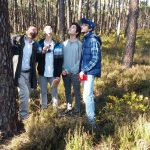Podrobnosti projekta
This project has made it to the Jury Rating!
Take his car´s plate and throw yourself to the air
Tema: BIONIKA
Tip projekta: Presentation
This project is aimed to create a model of biomonitoring of air quality in the municipality of Ovar in Portugal, using lichen diversity as bioindicators of atmospheric quality #SciChallenge2017
Motor vehicles and factories are sources of sulfur dioxide. Therefore, a high car traffic and the proximity of industrial areas lead to a higher concentration of this gas.
In order to indirectly show the air pollution levels, we counted the number of cars on the roads in front of three pine forests.
The absolute frequency in the three pine forests was quantified. The first forest, near a large industrial zone, a national road with a lot of movement and a shopping center Dolce Vita; The second pine forest chosen is located near a youth hostel and a national road with a high rate of car traffic. The third pine forest under study is located, instead of the others, in the periphery of the city and near a secondary road with little movement.
In order to reinforce the obtained data, the various lichen species at different concentrations of sulfur dioxide were submitted in laboratory in isolated acrylic boxes. In order to vary the concentration of the gas under study, aqueous solutions were prepared with different masses of potassium metabisulphite and, subsequently, different concentrations of SO2 inside the boxes (using stoichiometric calculations).
We can conclude that the different lichen species have different sensitivities to the studied gas, since these living beings are found in different quantities in the different pine forests and are located in the direction of the cardinal points opposite to the polluting sources and in the horizontal farther transects of these. These data could be confirmed in the laboratory since the different species of lichens show different percentages of necrosis for different concentrations of sulfur dioxide. Within the lichens analyzed the most resistant species is Parmelia caperata and the less resistant ones (the best bioindicators) are Parmelia perlata, Usnea rubicunda and Evernia prunastri.
Motor vehicles and factories are sources of sulfur dioxide. Therefore, a high car traffic and the proximity of industrial areas lead to a higher concentration of this gas.
In order to indirectly show the air pollution levels, we counted the number of cars on the roads in front of three pine forests.
The absolute frequency in the three pine forests was quantified. The first forest, near a large industrial zone, a national road with a lot of movement and a shopping center Dolce Vita; The second pine forest chosen is located near a youth hostel and a national road with a high rate of car traffic. The third pine forest under study is located, instead of the others, in the periphery of the city and near a secondary road with little movement.
In order to reinforce the obtained data, the various lichen species at different concentrations of sulfur dioxide were submitted in laboratory in isolated acrylic boxes. In order to vary the concentration of the gas under study, aqueous solutions were prepared with different masses of potassium metabisulphite and, subsequently, different concentrations of SO2 inside the boxes (using stoichiometric calculations).
We can conclude that the different lichen species have different sensitivities to the studied gas, since these living beings are found in different quantities in the different pine forests and are located in the direction of the cardinal points opposite to the polluting sources and in the horizontal farther transects of these. These data could be confirmed in the laboratory since the different species of lichens show different percentages of necrosis for different concentrations of sulfur dioxide. Within the lichens analyzed the most resistant species is Parmelia caperata and the less resistant ones (the best bioindicators) are Parmelia perlata, Usnea rubicunda and Evernia prunastri.
Opis projekta v angleščini
This project is aimed to create a model of biomonitoring of air quality in the municipality of Ovar in Portugal, using lichen diversity as bioindicators of atmospheric quality.
Motor vehicles and factories are sources of sulfur dioxide. Therefore, a high car traffic and the proximity of industrial areas lead to a higher concentration of this gas.
In order to indirectly show the air pollution levels, we counted the number of cars on the roads in front of three pine forests.
The absolute frequency in the three pine forests was quantified. The first forest, near a large industrial zone, a national road with a lot of movement and a shopping center Dolce Vita; The second pine forest chosen is located near a youth hostel and a national road with a high rate of car traffic. The third pine forest under study is located, instead of the others, in the periphery of the city and near a secondary road with little movement.
In order to reinforce the obtained data, the various lichen species at different concentrations of sulfur dioxide were submitted in laboratory in isolated acrylic boxes. In order to vary the concentration of the gas under study, aqueous solutions were prepared with different masses of potassium metabisulphite and, subsequently, different concentrations of SO2 inside the boxes (using stoichiometric calculations).
We can conclude that the different lichen species have different sensitivities to the studied gas, since these living beings are found in different quantities in the different pine forests and are located in the direction of the cardinal points opposite to the polluting sources and in the horizontal farther transects of these. These data could be confirmed in the laboratory since the different species of lichens show different percentages of necrosis for different concentrations of sulfur dioxide. Within the lichens analyzed the most resistant species is Parmelia caperata and the less resistant ones (the best bioindicators) are Parmelia perlata, Usnea rubicunda and Evernia prunastri.
Motor vehicles and factories are sources of sulfur dioxide. Therefore, a high car traffic and the proximity of industrial areas lead to a higher concentration of this gas.
In order to indirectly show the air pollution levels, we counted the number of cars on the roads in front of three pine forests.
The absolute frequency in the three pine forests was quantified. The first forest, near a large industrial zone, a national road with a lot of movement and a shopping center Dolce Vita; The second pine forest chosen is located near a youth hostel and a national road with a high rate of car traffic. The third pine forest under study is located, instead of the others, in the periphery of the city and near a secondary road with little movement.
In order to reinforce the obtained data, the various lichen species at different concentrations of sulfur dioxide were submitted in laboratory in isolated acrylic boxes. In order to vary the concentration of the gas under study, aqueous solutions were prepared with different masses of potassium metabisulphite and, subsequently, different concentrations of SO2 inside the boxes (using stoichiometric calculations).
We can conclude that the different lichen species have different sensitivities to the studied gas, since these living beings are found in different quantities in the different pine forests and are located in the direction of the cardinal points opposite to the polluting sources and in the horizontal farther transects of these. These data could be confirmed in the laboratory since the different species of lichens show different percentages of necrosis for different concentrations of sulfur dioxide. Within the lichens analyzed the most resistant species is Parmelia caperata and the less resistant ones (the best bioindicators) are Parmelia perlata, Usnea rubicunda and Evernia prunastri.
Finalist
123
1
Take his car´s plate a...
AG2Pres.PT
Random ProjectsOgled vseh projektov
Finalist
104
3
Internet
AG1Pres.CY





